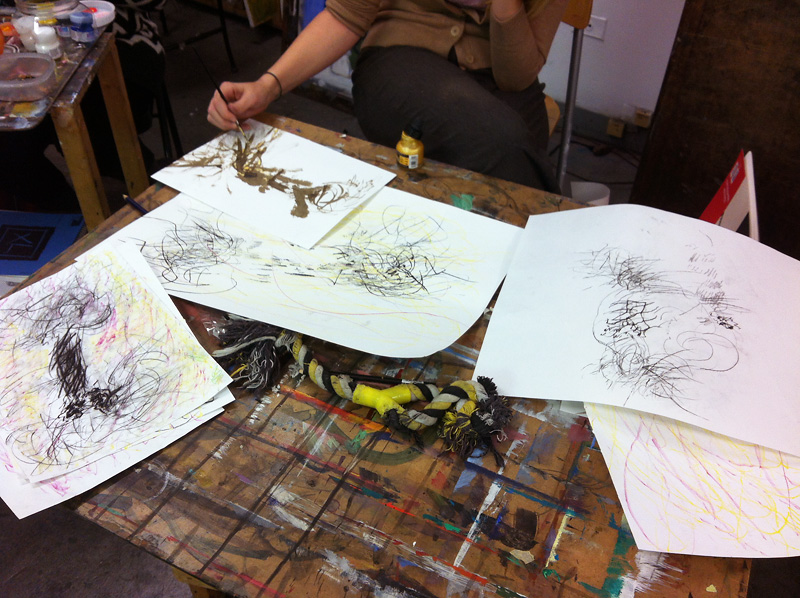
A couple of weeks ago, I finished teaching the final session of Experimental Drawing at Lillstreet. When I originally proposed the class, I included the following catalog description:
Do you practice drawing from observation while sometimes finding yourself yearning for inspiration and new ideas? Experimental drawing techniques are great tools for overcoming rigidity and tapping into the imagination. This class will begin by introducing you to drawing methods developed by the surrealists. We will use inkblots, rubbings, drawn collage, masking, and other ways of letting loose while incorporating traditional drawing methods into the process as well. We will then devise our own experiments and techniques that will help build your creative muscle.
With all our combined resources, the class proved to be exceedingly imaginative and inventive. I tend to approach teaching as a facilitator and was thrilled to receive lots of appreciation for my role in this class. Regarding the idea of facilitation as a teaching philosophy, I probably ought to save that topic for another time. What I would like to write about here is my personal experience with the class, which was surprisingly unprecedented. Although I expected to have just as much fun as I indeed did, I didn’t expect this class to be in other ways opposite of my teaching experiences to date.
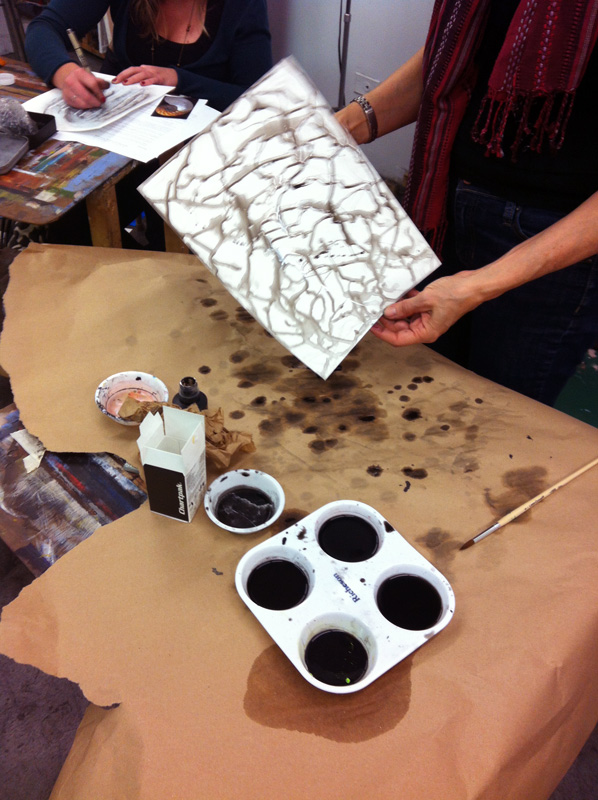
I am usually appointed to teach courses that offer students a certain measure of control over materials and equipment – courses that are chiefly centered on fundamental and/or specialized skills in studio-based art. This has ranged from the careful use of movements on large format view cameras to the construction of intricate yet sturdy forms in clay. In order to learn these skills, students would often solve problems, study their mistakes, and work towards the mastery of a given material through practice. In this experimental drawing class, however, I had to find a way to approach the subject from the opposite direction: I needed to encourage students to relinquish as much control as possible and to basically mess everything up! In theory, I already knew that alternative practice was going to be the objective of this class. After all, I had proposed the class as an experimental one, and the curriculum was relatively open to interpretation. What I didn’t realize was just how divergent the teaching atmosphere would be from a typical environment. I found myself saying things like “You’re doing too good of a job!” which was, needless to say, greeted with amusement and laughter.
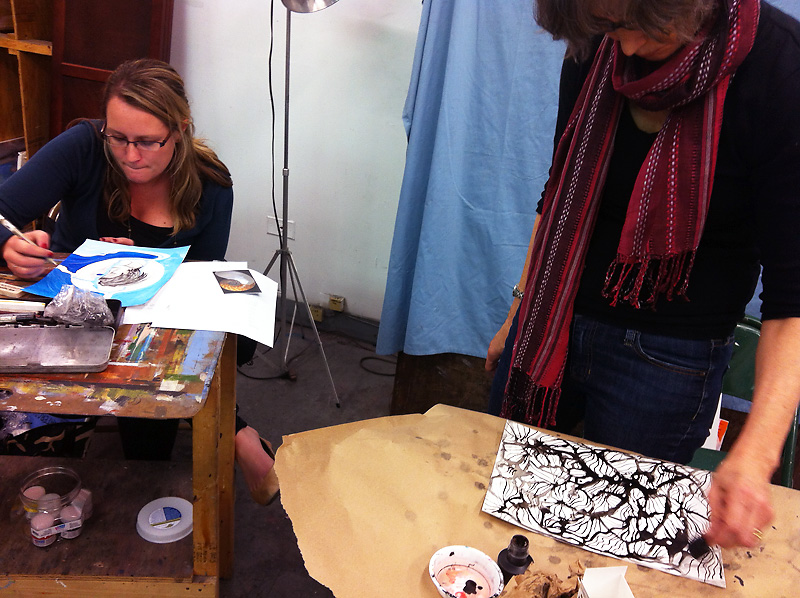
With the contrast between chance and control as one of the pivotal questions in my own artwork, I have found intuitive ways to resolve this problem and achieve a desired balance (to my own liking). But how does one impart this intuition to students without being prescriptive and thus defeating the purpose of the class? We had four sessions, a time period much shorter than the typical 16-week semester course. This posed a curriculum challenge: should this class present a cornucopia of samples, or focus on just a few specific techniques? The skill levels were mixed – some students had very little experience with drawing, while others had advanced representational skills.
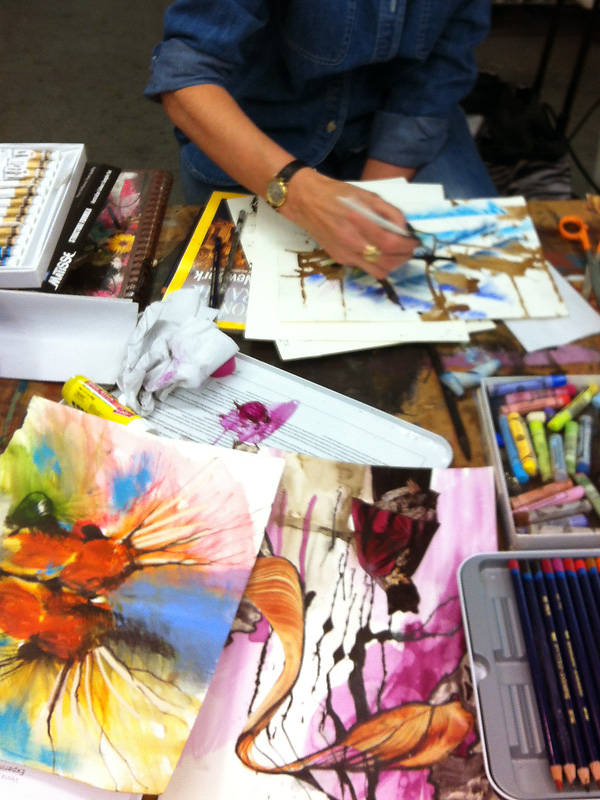
ersBefore getting too experimental, I decided to turn to traditional surrealist methods on the first day of class – to employ several of those liberating drawing techniques with French names: Frottage, Grattage, Eclaboussure, Soufflage, Decalcomania, and so on. The students approached these methods with a vast amount of enthusiasm and sophistication, creating pages and pages of intriguing experiments that left me with that feeling of motivation to run back to my own studio. For the sake of effective teaching however, I looked for repeating tendencies and discovered a few unexpected trends: using the same direction, speed, and pressure; conceptually isolating each technique instead of allowing one activity to guide the next; filling of the whole page; and every so often using color in an arbitrary manner. None of these things are universally negative, but in this class they stood out simply as habits, not choices. Although I did keep these things in mind on the second day of class, I will need to spend some extended pondering and research to truly resolve this challenge with dedicated assignments that are designed to offset the habits. I am curious to see what happens and how this unfolds next time I teach the class.
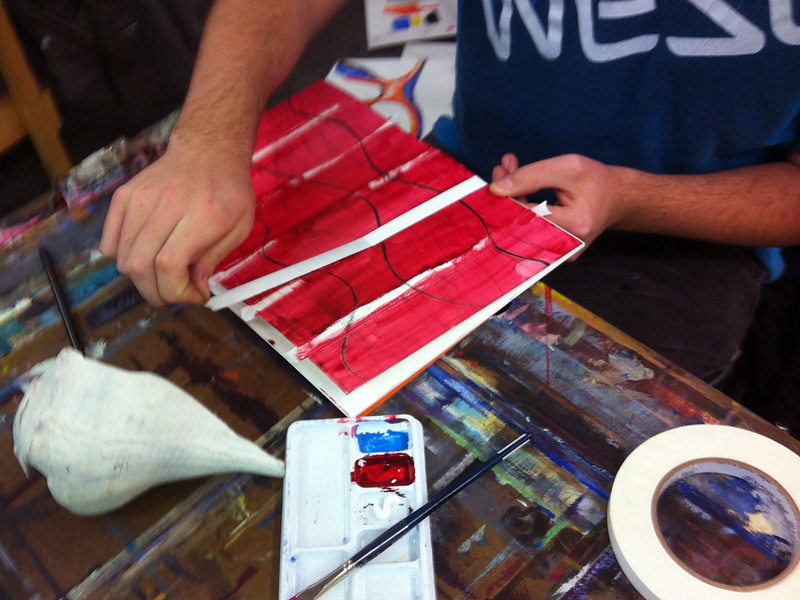
For the second day of class, I compiled a list of techniques in the form of a handout. I found some of them in drawing books, while others were simply my own blended versions of alternative drawing methods. On this day I noticed that some techniques worked better for beginners while others were more beneficial to advanced students. I had read somewhere that people derive a certain amount of pleasure from having just enough skill to feel at ease with the work while not having so much expertise as to diminish the challenge. I definitely recognize these principles in my own experience with drawing. Although I don’t remember where I saw this study, or why it was posted, I remember that the example referenced playing a musical instrument . In this drawing class, I will need to find the middle ground between boredom and impossible challenge, an idea that depends on the difficulty of each exercise and how it might benefit students with differing skill levels. In the future, I will divide the exercises into two lists: beginning and advanced, and then I’ll let students choose the grouping they feel most comfortable with.

Since this was a brand new class, I continuously kept asking students for feedback and ideas. During the second day, a couple of students requested a more rigorously structured assignment that would help them identify how to develop their work from one step to the next. This may sound ironic and counter-productive to the theme of this class (as it does to me now, reading this) but it made perfect sense within the context of the hour. I had initially handed out a list of methods and allowed students to pick from them freely, in any order, applying any technique to their liking. This was too loose of a structure. Students wanted something that would help them discover their own ways of discerning “good” experiments from “bad” experiments. The request for rigor triggered my plans for the third day of class.
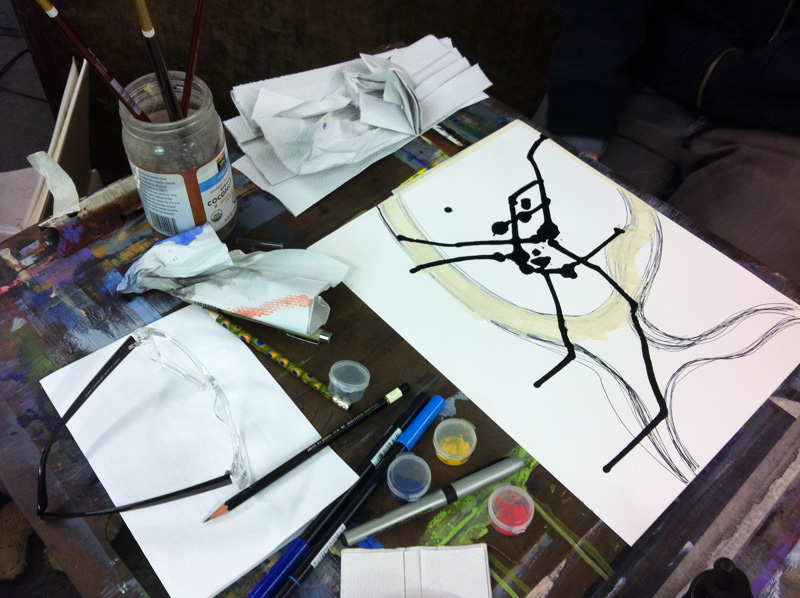
On the third day, I tried the overtly structured approach. First, before class, I asked students to bring a trivial/insignificant but conceptually meaningful object (this was not meant to be confusing). I requested something disposable that they wouldn’t be particularly careful with, but something that would incite lots of interesting ideas for drawing. Students brought a paper cup, a ball of twine, an apple, a pear, bones, eyeglasses, a dog toy, and various other fun things to draw. The chosen object was to serve as an anchor for the work – a way of relieving the perceived gravity of subject matter. In the spirit of the surrealists, the point of this class was to maintain momentum without too much interference or obstruction from the “ego.” Unlike the surrealists, however, we had to achieve this without employing sleep deprivation, alcohol, drugs, or hypnotism.

We began the third day with a set of 3-minute warm-ups, mostly using the “insignificantly-meaningful” object. We spent time drawing with the non-dominant hand, staring at the object and then drawing with eyes closed, creating rubbings from various textures around the room, continuously and intentionally shifting the quality of line and gesture, drawing the object on various portions of the page while leaving the rest blank, filling the page with the object while leaving very little negative space visible, and visually moving through the object while purposely leaving out and ignoring the contour lines. After we completed these exercises, I asked the students to combine their favorite results and work from there. This was a relatively successful day. The students were very happy with the exercises and their drawings, although I secretly wanted to see more outrageous results. I need to strike a balance with assignments that are both structured and freeing at the same time.

The fourth day was dedicated to the exquisite corpse game. We sat in a circle and began an exquisite corpse, spending 30 minutes on a section and then passing the paper to the next person, clockwise. The results were shocking, as an interesting pattern presented itself. Each drawing had very prominent repeating forms, as though we all read each other’s minds. The exercise raised questions about probability, statistics, psychology, and even parapsychology. It was uncanny, and it made for an interesting conclusion to the class.
I will be teaching this course again in March with some revised assignments and new ideas based on what I discovered.
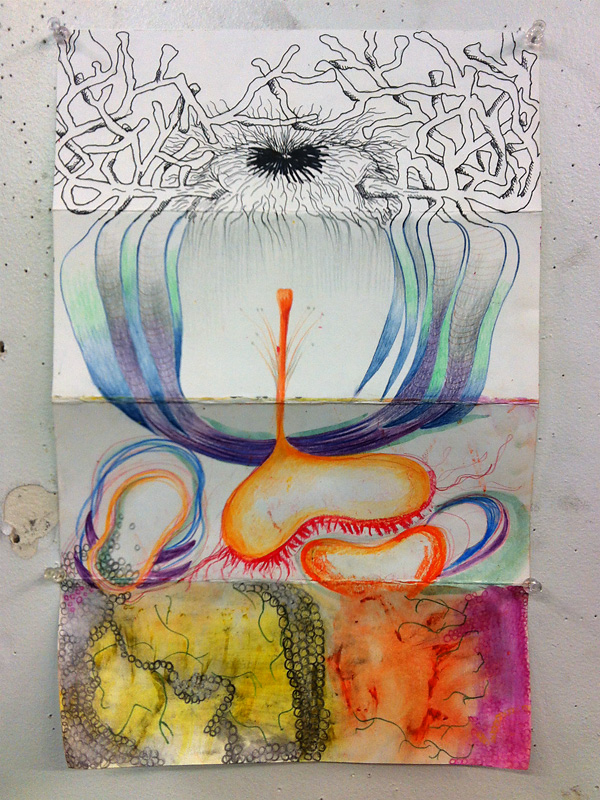
Thanks for sharing your reflections about your class. I am developing a class to “fit all levels” and calling it a Side by Side drawing class..so that all skill levels would be comfortable. What you shared here has given me the insight of how I want to structure this. I can already see that I should have done this as a series, instead of a one day workshop. Again, thank you.
Great post. I have been assigned to teach an alternative drawing class and found your post very helpful. I was wondering if you had other projects and assignments I would be able to employ? Thanks